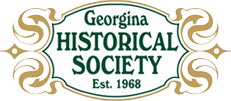Click to Download the PDF
Download the Word Doc
President’s Message
What an interesting year this has been as I approach the end of my second year as the president of the Georgina Historical Society. The GHS has been doing pop-up appearances at the Sutton Farmer’s Market, hosting monthly meetings with entertaining speakers, and presenting Harvestfest at the Georgina Pioneer Village, among many other things. Legislated changes to how Not-for-Profit Corporations operate created a lot of work in the background, and I must thank Kim Brady for taking the time to understand the legislation, doing the work required, and getting it all sorted out.
It was over fifty years ago that the Lake Simcoe South Shore Historical Society, under the leadership of Nena Marsden, envisioned some way to commemorate the area’s rich history. In 1975, after changing the name of the society to the Georgina Historical Society, historic buildings from around Georgina started to be moved to land supplied by the Town, eventually resulting in the preservation of 15 historic buildings that would have otherwise been destroyed. Fifty years later the Georgina Pioneer Village, now under the ownership of the Town of Georgina, is thriving.
I must also mention that our Annual General Meeting, being held on November 21 at the Sutton Legion, is fast approaching. Elections for the board of directors will take place, and if you want to get involved in the Georgina Historical Society, please contact any board member and we’ll put your name in for nomination. I am very excited to tell you that we have engaged a most interesting speaker this year, Dan Buchanan, who will share with us the story of the HMS Speedy, lost in a storm on Lake Ontario over 200 years ago. Details of this interesting evening are laid out in full later in this newsletter and I am looking forward to seeing you there.
I will also mention that we are taking a break for Christmas, so our next general meeting will be coming in January. There will be an issue of our newsletter for December.
Thank you all for your support and good will over the last year, and best wishes for you and yours in the upcoming holiday season.
Paul Brady, President, Georgina Historical Society
Thanksgiving
For many, our recent Thanksgiving weekend kicked off the autumn season. People across the country spent it raking leaves, harvesting, shutting down the family cabin, and hopefully, eating a delicious meal surrounded by friends and family. In Canada it has been traditionally celebrated on various dates in October and early November. But where did this tradition come from? Believe it or not, Thanksgiving in Canada, or at least the land that would become Canada, has its own history, separate from our American counterparts. Traditions of giving thanks long predate the arrival of European settlers in North America. First Nations across Turtle Island have traditions of thanksgiving for surviving winter and for receiving crops and game as a reward for their hard work. These traditions may include feasting, prayer, dance, potlatch, and other ceremonies, depending on the peoples giving thanks.

In 1578, English explorer Martin Frobisher and his crew gave thanks and communion was observed, either on land at Frobisher Bay, in present day Nunavut, or onboard a ship anchored there. The explorers dined on salt beef, biscuits, and mushy peas and gave thanks through Communion for their safe arrival in then Newfoundland. This is now accepted as the first “Canadian” Thanksgiving, forty-three years before the first “American” Thanksgiving. Forty-eight years later on November 14, 1606, inhabitants of New France under Samuel de Champlain held huge feasts of thanksgiving between local Mi’kmaq and the French. Though not known at the time by the settlers, cranberries, rich in vitamin C, are credited with helping avoid scurvy. The neighbouring Mi’kmaq likely introduced the French to cranberries, or as they called them, petites pommes rouges (little red apples). Champlain’s feasts were more than an annual affair. To prevent the scurvy epidemic that had decimated the settlement at Île Sainte-Croix in past winters, the Ordre de Bon Temps (Order of Good Cheer) was founded, offering festive meals every few weeks. Medical treatises recommended better nutrition (more food) and entertainment to combat scurvy.
However, despite this history of uniquely Canadian thanksgivings, our modern concepts of Thanksgiving were influenced by our American neighbours. Foods that are associated with a “traditional” Thanksgiving, such as North American turkey, squash, and pumpkin, were introduced to Nova Scotians in the 1750s. After the American War of Independence, the arrival of the United Empire Loyalists ensured the continuation of spreading this “traditional” fare to other parts of the country.
Today Canadian Thanksgiving is held on the second Monday of October every year, or at least it has been since Canadian Parliament declared it so on January 31, 1957. Before this, Thanksgiving in Canada had been held sporadically, often coinciding with other major events and anniversaries. In 1879, Thanksgiving was officially declared a national holiday to be held on November 6th.
The most recent date change to the second Monday in October was largely a result of the first and second world wars, which we officially remember each year on November 11, Remembrance Day. This was so that the two holidays would not fall on the same weekend.

Thanksgiving in Canada coincides with the completion of harvest in much of the country.
Library and Archives Canada / e011176904-v8
As Thanksgiving in Canada has historically been celebrated on several different dates, it is fitting that, even though it is usually observed on a Monday, families are equally as likely to celebrate on Saturday or Sunday.
Most Canadians embraced the change of date to October, since that period better coincides with the actual completion of harvest in much of the country.
Parliament officially declares Thanksgiving as “a day of general thanksgiving to almighty God for the bountiful harvest with which Canada has been blessed.” While this mandate for Thanksgiving may not be observed by all Canadians in its entirety, the ideas of being thankful, of spending time with family, and sharing a delicious meal still remain.
Edited and adapted from: https://www.canadashistory.ca/explore/arts-culture-society/the-history-of-thanksgiving-in-canada
Mail Services; a History to 1867 – Part 2
By Bob Holden
Since the beginning of the twentieth century, the frequency and speed of our mail service in settled parts of Canada could be measured in days and even hours in some places. It was not always so. It wasn’t until 1835 when two postal officials were appointed: William Henry Griffin, Deputy Postmaster General for Lower Canada, and Charles Berczy for Upper Canada. The population of Upper and Lower Canada had become simply too large for a single official to handle. Lord Durham’s report of 1839 advised that “the control and revenue of the Post Office should be given up to the Colony” and that regulation and control would be “better served” if managed by the colonial legislatures, though he still felt that “the management of the Post Office throughout the whole of British North America should be conducted by one general establishment.”
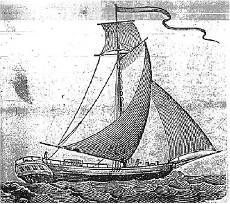
1825 mail packet boat
New British postal reforms were introduced in 1840 calculating the cost of postage based on weight only with uniform rates of postage applicable to the entire country. British postage stamps were introduced leading to the appearance of stamp boxes for storing the postage stamps now necessary for the posting of mail. In 1841, Upper and Lower Canada were reunited as the Province of Canada renaming them Canada West and Canada East for administrative purposes. Exchange post offices to the United States were established at Woodstock, New Brunswick, Québec, Stanstead, Montréal, Prescott, Brockville, Kingston, Toronto, Queenston, Sandwich, and Niagara, and by 1842, daily mail service during the summer months between Montréal and Kingston was introduced.
Early on mails moved by water during navigation season and a reduced service operated overland during the winter months
An agreement on Postal Services within the colonies was reached in 1849 by the legislators in the British North American provinces. All that remained was official approval from the British Parliament which soon followed on July 28th, 1849. The legislation provided a reduction in postage charges on all letters passing between places within the provinces or within British North America to a uniform rate of three pence per one-half ounce (14 grams). Charges for some newspapers were removed entirely. This British Act was quickly followed in the Province of Canada with similar legislation in New Brunswick, Newfoundland, Nova Scotia, and Prince Edward Island passing control of the Post Office to the provincial governments in 1851.
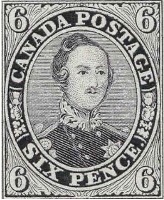
By 1850 sail had largely given way to steam as a reliable way to move mail over Canada’s major water routes. During the navigation season, mail steamers regularly carried mail from Kingston to Montréal, and from Montréal to Québec. In 1852 these services were put on interconnecting schedules and extended to the head of Lake Ontario to speed up the mail from Canada West. By 1865 there were mail steamboats on the Upper Great Lakes connecting Parry Sound, Collingwood, Sault Ste. Marie and Fort William with the US Postal Service. A weekly steamer service also brought mail from Québec to the Gaspé Peninsula and the ports around the Gulf of St Lawrence. In 1860 the postal department decided to establish its own Atlantic service from Montréal to Liverpool, England. The initial years were disastrous with several sinkings of vessels carrying the Royal Mails.. New rules made the service safer, more reliable and less costly.
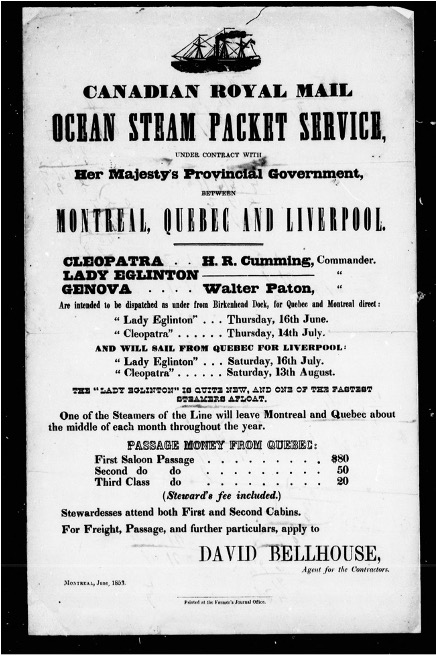
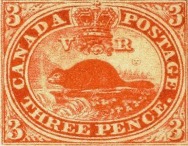
The first Canadian stamp, the Three Penny Beaver designed by Sir Sandford Fleming, was one of the world’s earliest examples of a pictorial stamp. Postage stamps were first issued in the Province of Canada on April 23rd, 1851 and were on unperforated sheets to be cut by Postmasters; Sandford Fleming designed the first three postage stamps of the Province of Canada. The Six-Pence Consort, issued 17 May 1851, was the second in this first series. In 1857, the Post Office department changed to perforated sheets of postage stamps to facilitate separation into single stamps, and in 1858 the first perforated stamp, the half-penny rose, was issued.
The first mail services aboard trains were introduced in 1854 and ran until the Railway Mail Service was finally abandoned in 1971. By February 1, 1854 the Money Order Branch of the Post Office (Province of Canada) had commenced operations and was quickly followed, on May 1, 1855, with the introduction of Registered Mail. In October 1856, a registration system for letters passing between Canada and the United States was applied, in an agreement with the U.S. Post Office. The Grand Trunk Railway between Brockville and Toronto was completed and, and by 1857, delivery of mail between Québec and Windsor was reduced to 49 hours from 10½ days in 1853.
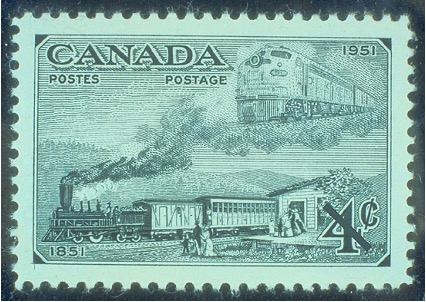

In 1863 the first Canadian Postal Guide was compiled containing the chief regulations of the Post Office. Issued in January, it replaced post office lists that contain much less information. Later, the Guide became a good source of information for postal historians and philatelists.
By 1864 regular conveyance of the mail by steamboats sailing on Lake Huron and Lake Superior was established. On Lake Huron, the trips between Collingwood and Sault Ste. Marie were weekly. On Lake Superior between Sault Ste. Marie and Fort William, trips were made every fortnight.
On July 1, 1867 New Brunswick, Nova Scotia and the Province of Canada formed the Dominion of Canada. Postal systems from Halifax to Fort William on Lake Superior were merged giving Canada 2333 post offices.
Sources:
https://en.wikipedia.org/wiki/Postage_stamps_and_postal_history_of_Canada
https://www.historymuseum.ca/cmc/exhibitions/cpm/chrono/chs1841e.html
https://www.historymuseum.ca/cmc/exhibitions/cpm/chrono/ch1854ae.html
https://www.historymuseum.ca/cmc/exhibitions/cpm/chrono/ch1854ae.html
https://www.worldvintagestamps.com/canadian-postage-stamps-history/
https://en.wikipedia.org/wiki/Packet_boat
Steamboat Trivia
RMS Segwun
Built originally in 1887 as the SS Nipissing, she was converted from a paddle-wheeler and rebuilt in 1925 as the twin screw RMS Segwun is the oldest of three ships remaining in the world still carrying the status of Royal Mail Ship (RMS).
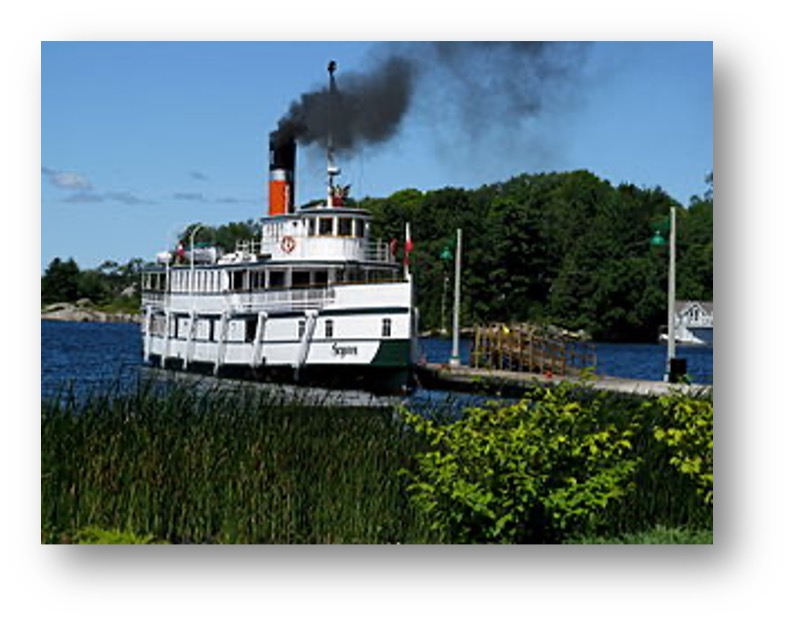
Our Pioneer Ancestors
Last month we erred with the Postmaster’s name for Pefferlaw; we clicked on the wrong directory in our listings instead of Lovell’s Canada Directory of 1851. It should have been Mrs. Jean Johnson as Postmaster of Pefferlaw instead (thanks Karen!). In 1851 the directories listed a total of only four post offices in Georgina and North Gwillimbury Townships altogether. By 1895, Might’s Gazetteer and Directory for that year listed six post offices in Georgina Township and five in North Gwillimbury. It also noted their mail frequency and transportation linkages by stage or by rail. These are reproduced below. Because of the railways and better roads, communications and transportation had improved significantly since the middle of the nineteenth century.
For Georgina Township
Baldwin – Postmaster: W. L. Crittenden. Daily mail, Grand Trunk Railway to Sutton and Toronto.
Pefferlaw – Postmaster: George Johnson. Mail three times weekly and stages three times weekly to Cannington (we suspect the stages were enroute from Sutton but not stated).
Sutton – Postmaster: John R, Bourchier. Daily mail, daily stages to Newmarket and tri-weekly to Cannington, Grand Trunk Railway to Toronto
Udora – Postmaster: R. S. Webster. Daily mail and daily stages to Sunderland via Vallentyne.
Vachell – Postmaster: Robert McClellan. Daily Mail, daily stages to Sutton.
Virginia – Postmaster: John Kay. Mail semi-weekly, stage three times per week to Sutton (most likely part of the route from Sutton to Cannington via Virginia and Pefferlaw).
For North Gwillimbury
Belhaven – Postmaster Neil Morton. Mail daily, stages daily to Newmarket and Sutton,
Brown Hill – Postmaster John Brown. Daily mail and Grand Trunk Railway (Ravenshoe Station ¼ mile) to Toronto and Sutton.
Keswick – Postmaster S. E. Morton. Daily mail, stage daily to Newmarket and Sutton (on the route through Belhaven, Roach’s Point, Queensville and Sharon).
Ravenshoe – Thomas Hindmarsh. Daily mail, stages to Ravenshoe Station and the Grand Trunk Railway line between Sutton and Toronto.
Roach’s Point (Roches Point) – Postmaster Francis Young. Daily mail, stages daily running enroute between Newmarket and Sutton.
Where in Georgina?
Our previous mystery location was identified correctly by our President Paul Brady. Thanks Paul! It’s finally solved…it was the Orchard Beach General Store! We have a new mystery location below …where is it, and what is it?
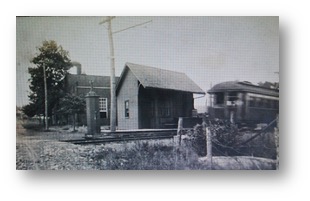
News
Cemetery Rehab Update –
The Mann Cemetery has been transformed and the contractors have done an amazing job. Eight thousand dollars had been budgeted for the rehabilitation of the headstones and the Company that was hired specializes in cemetery restorations and has done exceptional work. The rehabilitation of the abandoned cemeteries in Georgina is a multi-year project. The Project Manager for the Town of Georgina, Courtney Rennie, was our guest speaker at the October General Program Meeting and gave us a most interesting presentation.
Annual General Meeting –
The Meeting will be held on Thursday, November 21, 2024 at the Legion in Sutton. Meet and Greet at 5:30 and Dinner will be at 6:00 p.m. The cost is $30.00 per person and Kim has tickets available. The guest speaker is Dan Buchanan author of the book, “HMS Speedie”. This is also the time to renew your 2025 membership at $20 per person or $40 for a family. New board members are needed and welcome! Please consider joining the GHS as a board member, we have several vacancies. Contact any of the current board members for details.
ONCA Update –
The revised constitution for the Georgina Historical Society was approved at a special meeting held immediately prior to last month’s general meeting. All the By-law changes have been examined and approved by the legal firm, Keel Cottrelle before they were submitted to the Ontario Provincial Government ahead of their deadline.
Georgina Pioneer Village –
Experience the magic of Vintage Christmas at Georgina Pioneer Village! This festive celebration brings the warmth and nostalgia of a classic, vintage-inspired holiday to life. Enjoy festive fun for the whole family, from visiting Santa at the Train Station and crafting in the Schoolhouse to cozying up by the bonfire, snowshoeing, and the snowman scavenger hunt.
Date: Saturday, Nov. 30, 2024 Time: 4 p.m. – 7 p.m.
Location: Georgina Pioneer Village 26557 Civic Centre Rd., Keswick
From December 1st until January 6th, visit the village from 5-10 pm to stroll through enchanting holiday lights. Enjoy festive fun for the whole family, including photo ops, a snowman scavenger hunt, and special holiday programs. The holiday spirit will shine brightly throughout the festive season with the Festival of Lights. Explore the grounds of Georgina Pioneer Village and the Civic Centre for an enchanting holiday experience. Check the website above for details of the 2024 event.
Location: Georgina Pioneer Village and Civic Centre 26557 Civic Centre Rd., Keswick, L4P 3G1 Canada
Events
Thursday, November 21st – Our Annual General Meeting and dinner, at the Sutton Legion, 21 East Street; Roast Beef Dinner – $30; Meet and Greet 5:30 PM; guest speaker Dan Buchanan will present the story of the sinking of the ‘HMS Speedy’ in 1804.
Saturday, November 30th – Georgina Pioneer Village; Vintage Christmas from 4 to 7 PM Festive fun for the whole family, from visiting Santa at the Train Station and crafting in the Schoolhouse to cozying up by the bonfire, snowshoeing, and exploring the snowman scavenger hunt.
December 1st to January 6th – Festival of Lights, Georgina Pioneer Village, from 5 to 11 PM; new lighting is expected to be added to the Schoolhouse and Santa will make an early appearance at the Train Station.
Monday, January 6th – Board meeting, Quilter’s Cabin GPV, 2:00 PM
Tuesday, January 21st – General meeting, Bring and Bragg, location to be determined.

